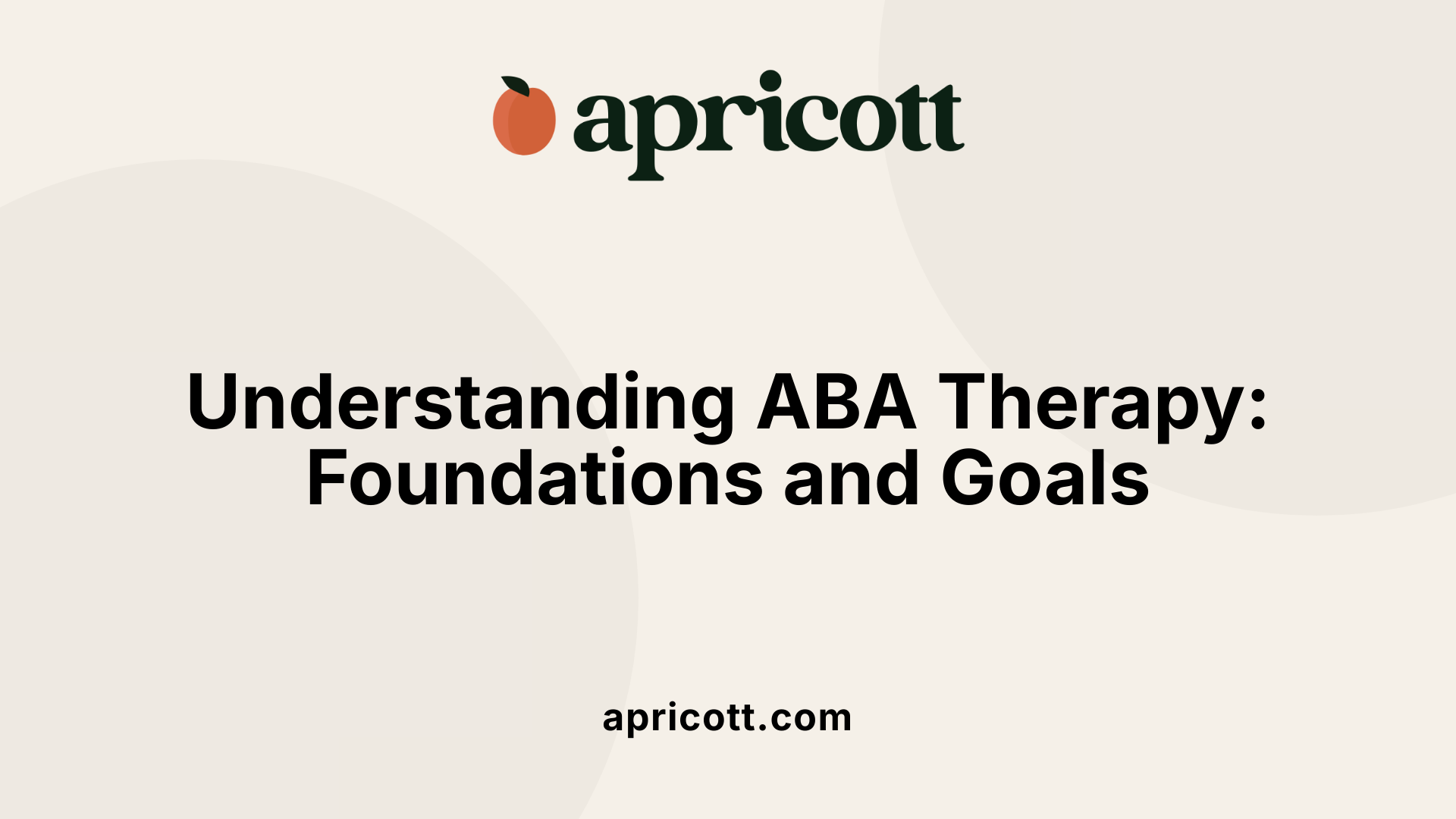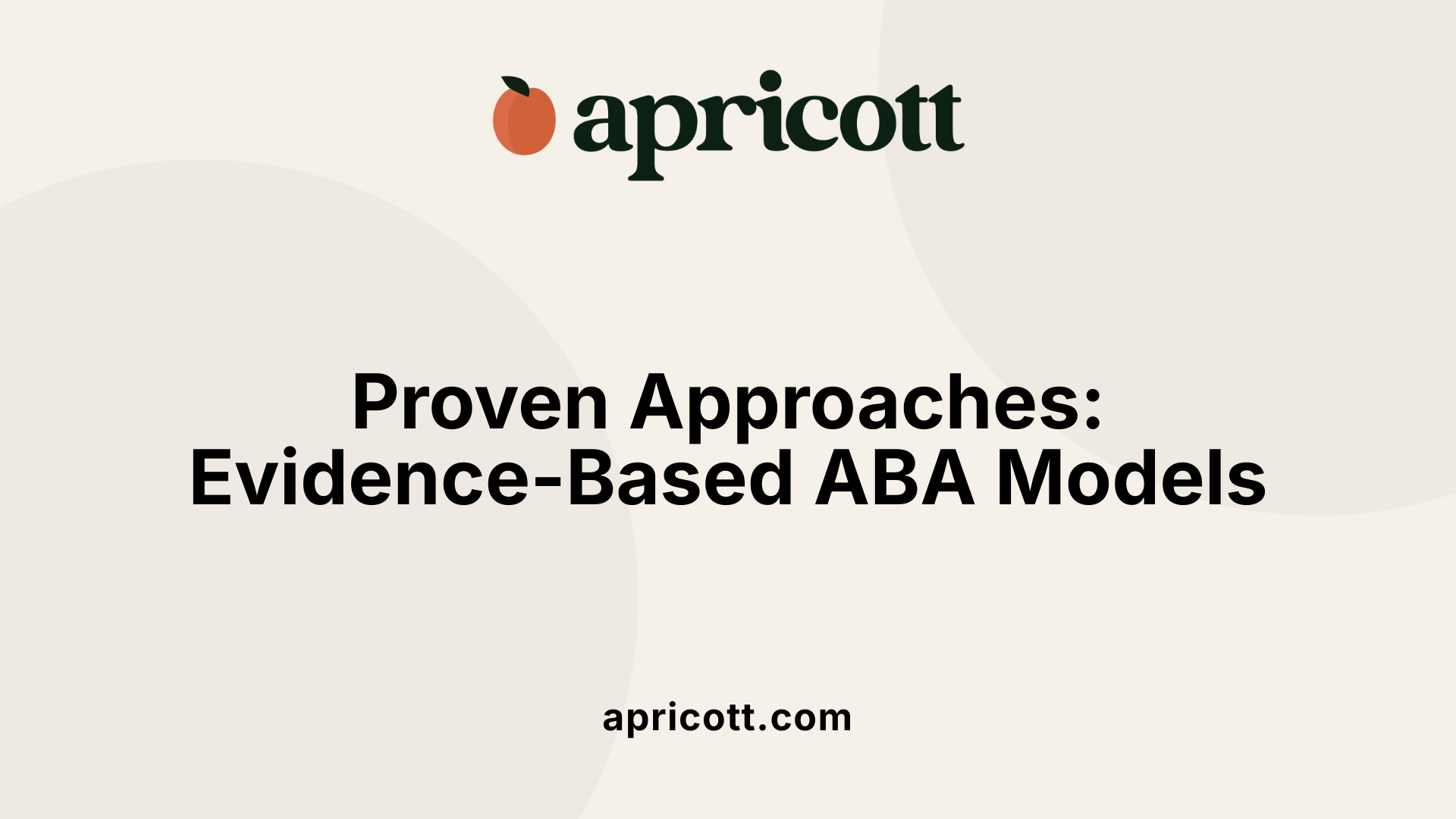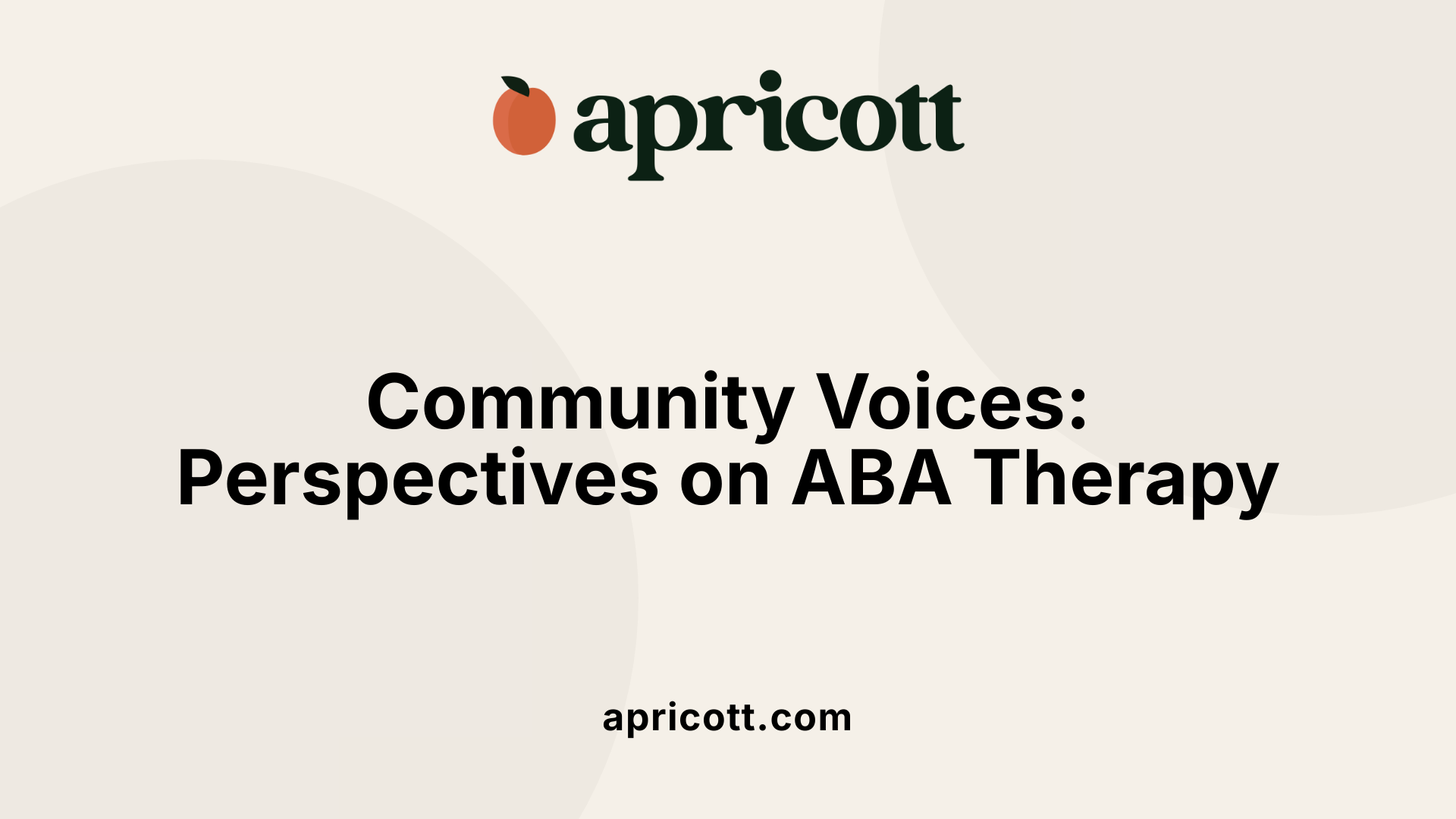A Comprehensive Approach to Autism Support
Applied Behavior Analysis (ABA) has become a cornerstone in the intervention landscape for individuals with autism. This evidence-based behavioral therapy offers tailored strategies aimed at enhancing meaningful skills and reducing problematic behaviors. Drawing from decades of research and clinical application, ABA supports individuals across the lifespan, fostering greater independence and quality of life. This article delves into the principles of ABA therapy, the professionals delivering these interventions, measurement of effectiveness, diverse delivery settings, and complementary approaches enriching autism support.
What is Applied Behavior Analysis (ABA) Therapy and How Does It Support Individuals with Autism?

Definition of ABA Therapy
Applied Behavior Analysis (ABA) therapy is a scientifically supported therapeutic approach based on the principles of learning and behavior. It focuses on how environmental factors influence behavior and systematically applies strategies to encourage positive behaviors and reduce problematic ones.
Behavioral Principles in Autism Support
ABA therapy investigates the antecedents and consequences influencing a person's behavior. Using this understanding, therapists modify the environment and responses to increase helpful skills and decrease harmful or disruptive behaviors.
Techniques Used
ABA employs several core techniques:
- Positive Reinforcement: Encouraging desired behaviors by rewarding them.
- Discrete Trial Training (DTT): A structured method breaking tasks into small steps, taught one at a time.
- Pivotal Response Training (PRT): Focuses on improving pivotal skills like communication initiation within natural, play-based settings.
These methods are often combined depending on individual needs.
Goals of ABA Therapy
The primary goals include improving:
- Communication and expressive language
- Social interactions and friendships
- Self-care and daily living skills
- Play and leisure activities
- Motor and academic abilities
ABA also aims to decrease behaviors that may interfere with learning or safety.
Individualized Treatment Plans
Each ABA program is tailored to the learner's unique skills, preferences, and challenges. A Board Certified Behavior Analyst (BCBA) designs and oversees these plans using detailed data collection to monitor progress and adapt interventions.
Developmental Gains and Quality of Life Improvements
Research shows early, intensive ABA therapy (often 25–40 hours weekly over several years) leads to significant gains in intellectual functioning, language, adaptive behaviors, and social functioning. This support enhances independence, social connections, and overall quality of life for individuals with autism.
Who Provides ABA Therapy and What Are Their Qualifications?

Who typically provides ABA therapy and what qualifications do these professionals have?
ABA therapy is delivered by a team of skilled professionals trained specifically in behavior analysis. The most common providers include Board Certified Behavior Analysts (BCBAs), Registered Behavior Technicians (RBTs), and sometimes Board Certified Assistant Behavior Analysts (BCaBAs).
Board Certified Behavior Analysts (BCBAs) qualifications and roles
BCBAs are highly trained specialists with advanced degrees in behavior analysis or related fields. They are responsible for conducting comprehensive assessments, designing individualized treatment plans, and supervising therapy implementation. Their expertise ensures that interventions are evidence-based and tailored to each learner's unique needs.
Registered Behavior Technicians (RBTs) roles and training
RBTs are paraprofessionals who work directly with individuals receiving ABA therapy. They implement therapy sessions, use techniques like prompting and reinforcement, and collect data on progress under the close supervision of a BCBA. RBTs must complete specific training and pass a certification exam demonstrating their competency.
Certification by the Behavior Analyst Certification Board (BACB)
Both BCBAs and RBTs obtain their credentials through the Behavior Analyst Certification Board (BACB), which sets rigorous educational, training, and ethical standards. This certification process ensures that professionals providing ABA therapy are qualified to apply scientifically validated methods.
Supervision and collaborative team approach
ABA services are often delivered through a collaborative team approach. BCBAs oversee and adjust treatments based on data collected, while RBTs engage directly with clients. Additional team members, such as speech therapists or occupational therapists, may work alongside behavior analysts to address all aspects of development.
This coordinated system ensures that ABA therapy is comprehensive, effective, and responsive to individual progress, helping people with autism and other developmental disorders achieve meaningful improvements in their skills and behaviors.
Measuring ABA Therapy Effectiveness: The Role of Data and Outcomes

How is the effectiveness of ABA therapy measured for individuals with autism?
Effectiveness in ABA therapy is tracked through ongoing, systematic data collection during therapy sessions. Therapists record detailed information on the individual’s progress toward behavioral and developmental goals, focusing on increases in positive behaviors and decreases in challenging behaviors.
Use of standardized assessment tools
To evaluate progress objectively, standardized assessment tools such as social-emotional inventories and communication checklists are utilized. These instruments provide reliable and valid measures that help capture improvements in social skills, language, adaptive behaviors, and emotional regulation.
Importance of treatment intensity and duration
Research highlights that the number of therapy hours per week (intensity) and the total length of treatment (duration) significantly influence outcomes. Studies reveal that longer-term ABA therapy—often spanning 1 to 3 years with 25-40 hours weekly—is more effective for developing key skills.
Evidence of developmental gains in intellectual functioning, language, and social skills
Data from multiple studies show improvements in intellectual functioning, language acquisition, daily living skills, and social abilities. These gains demonstrate the broad developmental impact of ABA when implemented with adequate intensity.
Dose-response relationship in ABA therapy
There is a strong dose-response link: higher intensity and longer treatment duration account for 50% to 67% of the variance in skill mastery. This means the more consistent and intensive the therapy, the greater the observable improvements in behavior and learning.
Monitoring and adjustment of intervention plans
Regular data analysis guides clinicians in adjusting treatment plans to match the learner’s evolving needs. Individualized goal setting and flexibility in intervention strategies ensure that therapy remains effective and responsive.
| Aspect | Description | Significance |
|---|---|---|
| Data Collection | Continuous recording of behavior and skill acquisition | Tracks progress and supports informed decision-making |
| Assessment Tools | Use of validated instruments like KIST and other inventories | Provides objective measurement of outcomes |
| Treatment Intensity | Hours per week of ABA therapy | Influences pace and extent of development |
| Treatment Duration | Length of time therapy is provided | Longer duration linked to sustained gains |
| Dose-Response Relationship | Impact of therapy intensity and duration on outcomes | Highlights importance of sufficient dosage |
| Intervention Adjustment | Modifications based on monitored data | Ensures alignment with learner’s progress and needs |
Diverse Settings for Delivering ABA Therapy

What are the different settings where ABA therapy can be provided?
ABA therapy is versatile and can be delivered across multiple settings tailored to individual needs and goals. One common approach is home-based therapy, where sessions are conducted in the child's natural environment. Here, a Registered Behavior Technician (RBT) works under the supervision of a Board Certified Behavior Analyst (BCBA), enabling practical skill-building in daily routines. Caregiver involvement is crucial in this setting, as parents and family members actively participate to reinforce learning and promote skill generalization.
Clinical and specialized centers offer another setting for ABA therapy. These controlled environments provide structured sessions with specially designed resources and staff expertise focused on behavioral development and social skills enhancement.
Schools often integrate ABA into educational programs to support children with autism in managing behaviors and improving communication within the classroom. This setting encourages direct application of skills in academic and peer contexts.
Community settings such as daycare centers, playgrounds, and recreational areas facilitate generalization of learned behaviors to natural social situations, increasing functional independence.
Lastly, telehealth and remote parent-mediated ABA have become increasingly prevalent. Through virtual coaching, BCBAs guide caregivers remotely to implement therapy strategies consistently at home, expanding access to services and empowering families.
These diverse settings ensure ABA therapy is adaptable, comprehensive, and maximizes developmental progress across real-life situations.
Evidence-Based ABA Practices and Intervention Models

Overview of Evidence-Based Practices (EBPs) in Autism
Applied Behavior Analysis (ABA) stands as a scientifically validated approach to treating autism spectrum disorder (ASD). Evidence-based practices (EBPs) are interventions that have undergone rigorous scientific evaluation confirming their effectiveness. In ASD treatment, EBPs must meet strict criteria including controlled experimental research, peer review, and safety evaluation. Various ABA practices, such as Discrete Trial Training (DTT) and Pivotal Response Treatment (PRT), have been classified as EBPs by prominent organizations.
Examples of ABA Teaching Styles: Discrete Trial Training (DTT) and Pivotal Response Treatment (PRT)
DTT uses a highly structured method of instruction where skills are broken down into smaller tasks and taught step-by-step using prompts and reinforcement. This method is especially effective for teaching specific skills like communication and academic tasks.
PRT adopts a naturalistic, play-based approach focusing on pivotal skills such as motivation, self-initiation, and social interaction. It incorporates child interests and natural reinforcers to promote learning in everyday settings.
The Early Start Denver Model (ESDM) Combining Developmental and Behavioral Approaches
The ESDM integrates ABA principles within a developmental framework targeting children aged 12 to 48 months. It emphasizes play, social exchanges, and shared attention to nurture language, social, and cognitive skills within natural environments. This broad approach aligns behavioral techniques with developmental needs, enhancing overall growth.
Meta-Analytic Evidence Supporting ABA Interventions
Meta-analyses of randomized controlled trials involving hundreds of children with ASD demonstrate promising effects of ABA-based treatments on socialization, communication, and expressive language. Intensive early ABA (typically 25-40 hours per week over multiple years) shows substantial developmental gains.
Subgroup Analysis Findings and Current Research Gaps
Some analyses reveal limited improvements in areas like motor skills, restricted behaviors, and cognition, indicating gaps in current evidence. While interventions such as ABA and ESDM show potential on core ASD symptoms, further high-quality research is necessary to establish definitive conclusions.
Role of Parental Involvement in Intervention Success
Parental involvement significantly enhances the effectiveness of ABA. Training and engagement of caregivers help generalize learned skills beyond therapy sessions, promoting consistency and long-term benefits.
| ABA Model | Description | Primary Focus |
|---|---|---|
| Discrete Trial Training | Structured, stepwise teaching of tasks | Skill acquisition, communication |
| Pivotal Response Treatment | Play-based, naturalistic teaching targeting pivotal skills | Motivation, social interaction |
| Early Start Denver Model | Combines ABA and developmental strategies for toddlers | Language, social, cognitive skills |
Complementary Interventions Supporting Autism Therapy

What Developmental Interventions Complement ABA?
Developmental interventions often work alongside ABA to bolster specific skills such as language and social interaction. Speech and language therapy is the most prevalent developmental approach, aiding individuals in understanding and using various modes of communication. These therapies focus on enhancing receptive and expressive language skills crucial for daily interactions.
Which Educational Approaches Assist Learning?
Educational treatments like the TEACCH approach emphasize visual learning and structured environments. TEACCH incorporates visual routines and classroom boundaries, creating consistency and predictability that support learning for individuals with autism spectrum disorder (ASD).
What Social-Relational Models Enhance Social Skills?
Social-relational approaches aim to improve social engagement and emotional connections. Popular models include DIR/Floor Time, Relationship Development Intervention (RDI), Social Stories, and social skills groups. These methods often involve parents and peer mentors to motivate and enrich shared social interactions.
How are Medications Used in Autism Therapy?
While no medications treat core ASD symptoms, certain drugs manage co-occurring issues such as anxiety, depression, seizures, sleep disturbances, and gastrointestinal problems. These medications require medical supervision and are targeted at improving overall quality of life.
What Role Do Psychological Interventions Play?
Cognitive-behavior therapy (CBT) is a common psychological approach helping individuals with ASD address mental health challenges like anxiety and depression. CBT works by modifying thoughts and behaviors, complementing behavioral therapies.
What Should Families Know About Complementary and Alternative Methods?
Many families explore complementary therapies including special diets, herbal supplements, chiropractic care, animal-assisted therapy, arts therapies, mindfulness, and relaxation techniques. While some find benefit, these should always be discussed with healthcare providers to ensure safety and consider evidence of effectiveness.
Table: Overview of Complementary Autism Interventions
| Intervention Type | Examples | Description and Role |
|---|---|---|
| Developmental | Speech Therapy | Enhances communication skills through structured practice |
| Educational | TEACCH | Visual supports and structured learning environment |
| Social-Relational | DIR/Floor Time, Social Stories | Builds social skills and emotional engagement |
| Medications | Anti-anxiety, anti-seizure | Manages co-occurring symptoms under medical supervision |
| Psychological | Cognitive-Behavioral Therapy | Addresses mental health challenges |
| Complementary/Alternative | Diets, animal therapy, arts | Supplemental methods used alongside conventional therapy |
Progress and Challenges: The Autism Community’s Perspective on ABA

Community support and acceptance of ABA therapy
Applied Behavior Analysis (ABA) therapy enjoys substantial support within the autism community, with many recognizing its value in improving skills essential for daily living and communication. Social media sentiment analyses reveal that opinions about ABA are predominantly positive or neutral, reflecting a broad acceptance of its benefits alongside ongoing dialogue about its implementation.
Social media sentiment analyses
Social media platforms, where families and individuals share experiences, have been instrumental in highlighting the varied perspectives on ABA. Studies indicate that a majority of users express appreciation for ABA’s role in advancing social skills and reducing challenging behaviors, although some discussions also underscore the need for sensitivity and personalization.
ABA’s focus on enhancing rather than changing neurodiversity
A vital aspect emphasized by advocates and practitioners alike is that ABA aims to support individuals in reaching their personal goals and improving quality of life without seeking to alter core neurological traits. This approach respects neurodiversity, ensuring the therapy does not stigmatize or pressure individuals to conform to typical behavior patterns.
Considerations of treatment approach evolution emphasizing positive reinforcement and individualized goals
The techniques and goals of ABA have evolved, incorporating developmental and learning theories with an emphasis on positive reinforcement. Modern ABA programs prioritize tailoring interventions to each individual's strengths, preferences, and challenges, thereby fostering a respectful and effective therapeutic experience.
Importance of respectful, person-centered care
Respectful, person-centered care remains paramount in delivering ABA therapy. This involves engaging individuals and their families, honoring their input, and creating interventions that align with their needs and values. Such an approach strengthens trust and promotes the best possible outcomes within the autism community.
Optimizing Outcomes: Integrating Data, Individualization, and Long-Term Support

Importance of comprehensive and long-term ABA interventions
ABA therapy’s effectiveness significantly increases when it is delivered as a comprehensive, long-term intervention. Research highlights that intensive ABA programs—typically 25 to 40 hours per week over 1 to 3 years—enable notable developmental gains in children with autism. Such programs address multiple domains simultaneously, including communication, social skills, daily living, and academic abilities, creating a robust foundation for lifelong growth.
Role of continuous assessment and adaptive treatment plans
Continuous data collection is integral to ABA therapy, allowing therapists to monitor progress meticulously. Using this feedback, treatment plans are regularly adapted to meet evolving needs and optimize outcomes. This dynamic approach ensures that interventions remain relevant and effective, targeting behaviors that enhance the individual's functioning while reducing problematic behaviors.
Collaboration with families and caregivers for skill generalization
Family involvement is a cornerstone of successful ABA therapy. Therapists work closely with parents and caregivers to promote skill generalization beyond clinical settings. Training caregivers to implement strategies at home helps reinforce new skills in natural environments, facilitating smoother integration into daily life and increasing the intervention's overall impact.
Impact of early intensive therapy on reducing need for later special services
Early intensive ABA intervention has been shown to produce substantial developmental improvements, often decreasing the need for specialized support in later childhood or adulthood. By addressing critical skills during key developmental windows, early therapy sets the stage for better independence and reduced reliance on special services.
Focus on lifelong gains including social connections, employment, independence
While much research focuses on young children, ABA’s benefits extend across the lifespan. Effective long-term interventions contribute to enhanced social connections, improved employment opportunities, and greater independence. These outcomes are fundamental to improving quality of life and supporting individuals with autism to thrive in various life contexts.
Advancing Autism Support Through Evidence-Based Interventions
Applied Behavior Analysis (ABA) stands as a foundational intervention for autism, firmly rooted in scientific principles and decades of empirical support. Delivered by qualified professionals across varied environments, ABA's individualized strategies yield meaningful improvements in communication, behavior, and adaptive skills. Measured by rigorous data collection and continuously refined, ABA therapy’s effectiveness grows with consistent intensity and tailored approaches. When paired with complementary developmental and psychological interventions, ABA fosters holistic growth for individuals on the autism spectrum. Embraced by many in the autism community, ABA’s respectful and flexible methodology underscores the importance of supporting neurodiversity while empowering individuals to reach their full potential. Continuing research and collaboration promise even greater advances in autism interventions, ensuring all individuals receive the personalized care necessary to thrive.
References
- Applied Behavior Analysis (ABA)
- Efficacy of Interventions Based on Applied Behavior ...
- Treatment and Intervention for Autism Spectrum Disorder
- Applied Behavior Analysis
- The 27 Evidence-Based Practices (and What They Mean)
- The effectiveness of applied behavior analysis program ...
- Applied Behavior Analysis (ABA)
- What is an ABA Therapist?
.svg)
.svg)








